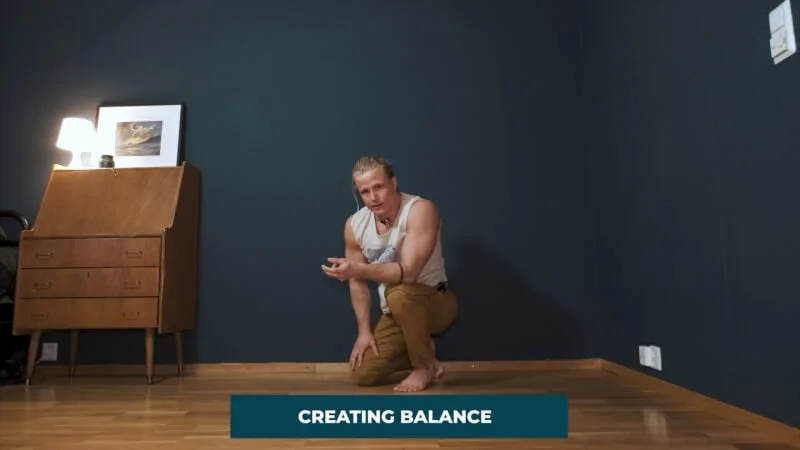5 Handstand Myths that will destroy your progress
The internet can be a great place, and it can also be a horrible place. It is a place full of information, but it might have even more shit information. When it comes to learning to handstand, the same applies. “4 weeks to Handstand!” ; “The Easy way to Handstand”, etc would fall under the second category: shit information. The goal of this article is to dispel a few common myths regarding handstands. Taking these myths into consideration, we are able to have a clearer perspective on how to view our handstand journey, as well as train for it more effectively and efficiently. Let’s get into it:)
Check out the full video handstand tutorial on 5 handstand myths to avoid
Myth 1: You should look backwards
The notion that you need to look backwards to properly perform a handstand is not only incorrect - it’s outrageous. It is way, way harder to perform a handstand looking backwards than looking between your hands - which is where you should be looking. Especially in the beginning of your handstand journey, the space directly between both of your hands is where you should be looking. As you progress, you can try to make it more challenging for yourself by looking backwards.
It is imperative that you look between your hands when doing the handstand.
Don’t look in front of your hands. Don’t look behind your hands. Look between your hands.
Myth: look backwards when performing a handstand
Truth: Look between your hands when performing a handstand
Myth 2: You need to open/flexed shoulders to do handstands
Let me be clear: in order to have a perfect line in your handstand, you do need to have flexed shoulders.
However, you don’t need to focus on this aspect alone right from the beginning of your handstand journey. If you aren’t able to maintain flexed shoulders while in the handstand that’s okay, there are ways to improve that.
Not flexed vs. flexed shoulders
In most cases, the reason why people’s shoulders are not properly flexed is because the person lacks adequate shoulder flexibility/mobility that is required to hold the proper position. Exercises such as the Alternating Leg Downward Facing Dog, Loaded Chair Bends, and Back Bend Hip Extensions will help in this case.
Loaded chair bends, alternating leg downward facing dog, and back bend hip extensions are all great exercises to increase flexibility/mobility in your shoulders
Flexibility and mobility are not things you can fix just by learning that you don’t have them. Improving the flexibility/mobility in your shoulders to the extent that you are able to hold a completely flexed shoulder position in a handstand will take time. It could take months, or even up to a year or more.
Don’t postpone your handstand journey just because your shoulders aren’t flexible enough. Rather, make the free handstand a goal for later in your journey, and add some goals to strive towards, that lie between where you are now and the free handstand.
Myth: You need to have completely flexed shoulders in order to do a handstand.
Truth: You can still do a handstand without flexed shoulders. Your line might not be as perfect, but you can do a legitimate handstand without flexed shoulders nonetheless.
Myth 3: You need a strong core to do handstands
While you might intuitively think so, you don’t need a lot of core strength in order to do a handstand.
Discussing the myth that you need a strong core, vs what you really need. check the clip out :)
The amount of core strength you need to perform a handstand is not more than what you need to perform a headstand. Therefore, if you are able to do a headstand, your core is strong enough to do a handstand.
Training the headstand will help you create the upside down awareness you need for a handstand. As well, if your core is strong enough for a headstand, it’s strong enough for a handstand.
What you do need, however, is strong shoulders. As well, you need awareness - that is, upside down awareness. Practicing headstands and forearm headstands is a great way to build awareness in your core and spine, which will apply directly to your handstand.
One thing to note is that, while you may not need a lot of core strength for the unassisted handstand, you will need core strength to get your feet up the wall when you are doing wall-assisted handstands.
Myth: You need to have a strong core to do handstands
Truth: You need to have strong shoulders and traps to hold the handstand, and good upside down awareness (particularly in your spine)
Myth 4: The handstand is about finding balance
Only one word needs to be changed here, but it makes a significant difference in how you should approach the handstand.
The handstand is not about FINDING balance.
The handstand is about CREATING balance.
A lot of people, particularly at the beginning of their handstand training, will kick up and hope the balance comes based on kicking up with the perfect force. If it doesn’t work, they’ll kick up again, and on and on. However, this is not the correct approach.
Discussing the myth that one needs to ‘find balance’ for a handstand
Using our hands, after entering the handstand, we create balance. I’ve gone into this more in depth here but, using our friend the wall, we need to train our hands in two ways.
We need to learn how to prevent ourselves from falling forwards(our legs going over our head) by learning to push back in our fingers.
We need to learn to prevent ourselves from falling backwards by learning to push in with our hand heel.
Myth: You need to find the correct balance point in handstand
Truth: You need to create the correct balance point to perform a handstand
Myth 5: You can learn a handstand in 4 weeks
As mentioned in the intro, anything or anyone telling you that you will quickly be able to conquer a perfect handstand is full of shit.
Unless you have previous experience in something applicable to handstands like handstand walks, you’re used to being upside down, or have experience in relevant sports with carryover to the handstand, the handstand journey is not a short one. Therefore what I recommend is creating intermediate goals, such as:
Headstand
Wall-assisted handstand
Kick up to wall-assisted handstand
Shapes in the headstand position
Create intermediate goals to strive towards on your handstand journey, such as the wall assisted handstand, kick up to wall assisted handstand, and practicing shapes.
There are lots of things you can set your sights on between where you’re at now and a full, clean, freestanding handstand, and I recommend you do so. You will find that as you remain consistent, you start to build awareness, strength, and balance and, hopefully, that motivates you to continue towards your end goal. Be prepared for that, and have fun along the way. :)
Myth: You can master the handstand in about a month’s time
Truth: Expect your handstand journey to take anywhere from 6 months to a year, or more.
Summary
Let’s summarize! How to improve your handstand journey by understanding these 5 myths associated to learning it:
You should look backward while doing the handstand. No! Look between your hands.
You need to have your shoulders flexed. Not true! A handstand still counts even if you aren’t able to flex your shoulders yet.
You need a strong core. Not necessarily. If you can do a headstand, you can do a handstand.
The handstand is all about finding balance. Nope! It’s about creating balance.
You can learn a handstand in 4 weeks. Unless you have previous experience, it will likely take longer. Enjoy the journey :)
Handstand Programs Beginner-Advanced
If you want MORE info on handstands: full programs with fully set exercise sessions, exercises with how-to descriptions and videos as well as form cues, please feel free to check out my app here.
Thanks as always movers, hope this was helpful for you and take care! If you have any questions, comments or criticisms hit me up here, on Youtube, or IG and I will try to get back.
Peace!
Leave a Comment :)
Share Post:















